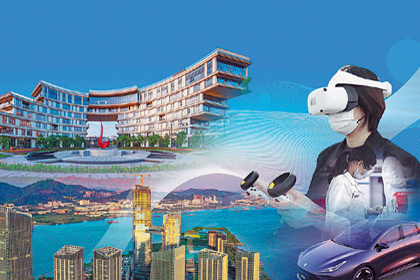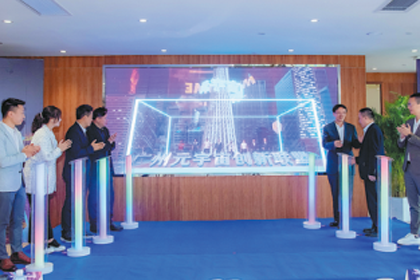Nansha on track to ride technological boom

Representative elements of Nansha's technological development. [Photo provided to chinadaily.com.cn]
Nansha district, an emerging innovation hub in Guangzhou, Guangdong province, is improving its research and development capacity by intensifying collaboration with universities and research institutes in Hong Kong and Macao.
As a major component of the international scientific and technological innovation center in the Guangdong-Hong Kong-Macao Greater Bay Area, the district was urged to grow into a base for scientific and technological innovation and industrial cooperation and strengthen the cooperative tie with Hong Kong and Macao in scientific and technological innovation in the Overall Plan for Promoting Comprehensive Cooperation among Guangdong, Hong Kong and Macao by Further Deepening Opening-up in Nansha District of Guangzhou, a new master plan issued by the State Council in June for the district.
One of the latest efforts along this line is the signing of an agreement with the Hong Kong University of Science and Technology (Guangzhou), or HKUST(GZ), which is located in the district, for synergy innovation across the board at the end of October.
Both sides agreed to strengthen cooperation in six aspects including setting up key innovation platforms, jointly solving core technology problems, and transforming and commercializing those achievements.
The district government, together with the Guangzhou city science and technology bureau, will earmark a sizable budget annually to support fundamental research and applied basic research of HKUST(GZ).
The district has also been in talks with universities and research institutes in the Greater Bay Area including HKUST, HKUST Fok Ying Tung Research Institute and Southern Marine Science and Engineering Guangdong Laboratory (Guangzhou) to set up joint labs or research centers.
They will focus on frontier fields of science and technology, research on advanced technologies and key generic technologies for industries, along with making contributions to high-level technological self-reliance, the district government said.
The Guangdong, Hong Kong & Macao (International) Youth Entrepreneur Hub, which is designed to house high-end research resources from Hong Kong and Macao, has secured five teams from leading universities in the Greater Bay Area, with the number expected to hit 12 by the year-end, said the district government.
Innovation platforms
In a bid to foster an outstanding regional innovation hub, the district has set up a multilayered innovation platform system called "1+1+3+N" for scientific exploration, heavyweight projects and top talents.
The first "1" refers to Nansha Science City, with the Mingzhu Science Park included. The science city, covering an area of roughly 100 square kilometers, will be the main venue for innovation development. Still under construction, it will have most of its facilities ready by 2025. The Mingzhu park, developed by the Chinese Academy of Sciences, will serve as the core part of the science city.
The institute for aerospace science and technology and the institute for an intelligent unmanned system will soon move into the park. The latter participated in the research on the underwater torch relay by robots, the first in Olympic history that occurred in the Beijing 2022 Olympic Winter Games in February.
The second"1" refers to the Southern Marine Science and Engineering Guangdong Laboratory (Guangzhou). With 55 top scientific teams in the fields of marine research led by 16 academicians and more than 1,000 scientists and researchers, it will have its core part of the complex completed by the end of this year, while its marine research base is expected to be upgraded as a State-level lab.
The "3" refers to the three major scientific and technological infrastructure facilities in the science city — cold seeps, unmanned marine scientific research and wind tunnel research. They mark a breakthrough in the district's development of large-scale scientific facilities and are expected to put the district in an advantageous position in marine research and aviation and aerospace industrial development.
The "N" refers to various innovation platforms in Nansha. They consist of 22 high-level scientific research institutes including those jointly launched by the Chinese Academy of Sciences or Shanghai-based Fudan University, as well as 353 innovation platforms including a national engineering research center for nature gas hydrate, one of three nationwide in 2021, which began construction in July.
Supportive policies
Putting talent attraction on top of the agenda, the district government of Nansha has stipulated a number of policies to lure unicorn companies and talents and help to boost its key industries, especially in semiconductor and integrated circuits, the metaverse and commercial aerospace.
Among the 10 measures to support innovation issued by the district government, high-level talent could get a housing allowance up to 10 million yuan ($1.41 million).
The new policy also allocates up to 100 million yuan to top-level teams working on the strategic industries of Nansha and to the new-type R&D institutes, 200 million yuan to each major innovation platform.
For companies specializing in the commercial aerospace industry that carry out research in the new areas of rockets and satellites or focus on the research or commercialization of the products that are essential to the industry, the local government will subsidize 20 percent of the R&D costs spent in the previous year, with the amount totaling up to 100 million yuan a year, according to the government policies.
As a result, 36 academicians and 17,000 top-level team leaders or professionals are working in Nansha, which has five academician research stations and 24 platforms for postdoctoral researchers, the latest statistics of the district government showed.
There are a total of 744 high-tech companies in Nansha, including a group of leading players in the industry of the metaverse that founded an industrial alliance. Twenty-five companies were selected as innovative unicorns of Guangzhou in 2022, including Cloudwalk, Pony.ai and Guangdong Aofei Data Technology.
World-class bay areas always coexist with world-class universities, said Lionel M. Ni, president of HKUST (GZ), so HKUST (GZ) and Nansha will hopefully take the same road that has proved to be successful. He said that in five years, the entrepreneurial ecology in the Qingsheng area, where the university is located, will boom, and the area, in the shape of Silicon Valley, will flourish.
Guan Chenghua, president and professor at the Center for Innovation and Development Studies of Beijing Normal University, said Nansha can be an important base for the transformation of the achievements from Hong Kong and Macao by combining the advantages from its manufacturing neighbors of Foshan and Dongguan with the strong innovation capabilities of the universities in Hong Kong and Macao.
chenhong@chinadaily.com.cn

Business representatives attend the opening ceremony of the metaverse alliance on March 25. [Photo provided to chinadaily.com.cn]
All rights reserved. Presented by China Daily









